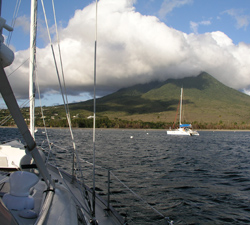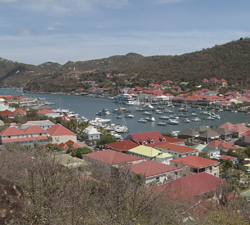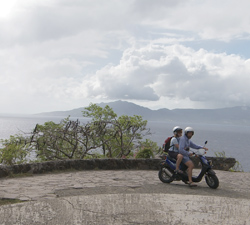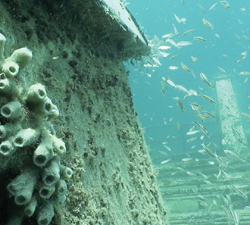Jewels of the French Antilles – Iles des Saintes and St. Barthélemy

By Sheryl and Paul Shard
 Spring is a beautiful time in the Caribbean. The trade winds become more gentle and the persistent northerly swells found in the winter boating season, formed by storms “up north”, subside. This general calming of conditions opens up a plethora of anchorages throughout the islands just when most cruising sailors are beginning to leave the Caribbean for home. Even the more popular anchorages become less crowded as a result. So why is everyone leaving?
Spring is a beautiful time in the Caribbean. The trade winds become more gentle and the persistent northerly swells found in the winter boating season, formed by storms “up north”, subside. This general calming of conditions opens up a plethora of anchorages throughout the islands just when most cruising sailors are beginning to leave the Caribbean for home. Even the more popular anchorages become less crowded as a result. So why is everyone leaving?
Most cruisers begin their departure in March to get an early start on the long trip north so that they arrive in home waters in time for summer festivities. Others start leaving the Caribbean in the early spring to get out of the hurricane belt in a leisurely fashion, preferring day sails to a big offshore jump out of the belt just before hurricane season officially begins in June. But what it means is that from April to June, the cruising is good in the Caribbean.
Our Spring 2009 cruise has been a delight. In early Apri,l we had discovered the less-visited islands islands of Saba and Montserrat. (See the June 2009 issue of CY.) As the end of April approached, we were finishing a wonderful cruise in Guadeloupe exploring the quiet corners of this French island, namely the string of magical islets that lie off Guadeloupe’s north coast and a trip down the Rivière Salée, a natural saltwater mangrove channel that deposited us in Pointe à Pitre, Guadeloupe’s main city where its large commercial port is located. (See the July 2009 issue of CY.) We spent a few days here in the Marina Bas-du-Fort stocking up the boat with needed spare parts from the excellent chandleries and topping up our ship’s stores with imported goodies from France.
 Guadeloupe is one of four territories presently under French sovereignty in the Caribbean – the two overseas departments of Guadeloupe and Martinique, plus the two overseas collectivities of St. Martin and St. Barthélemy (St. Bart’s). The territories are known as the French West Indies or Antilles Français. The word Antilles originated in the period before the European conquest of the New World –Antilia being one of those mysterious lands that appeared on medieval charts, sometimes as an archipelago, sometimes as continuous land drawn in various locations in mid-ocean between the Canary Islands and India. After Christopher Columbus’s first expedition in 1492, the Caribbean islands were called the West Indies, but since the islands comprised an extensive archipelago like the mystical Antilia, many European countries used the term Antilles instead.
Guadeloupe is one of four territories presently under French sovereignty in the Caribbean – the two overseas departments of Guadeloupe and Martinique, plus the two overseas collectivities of St. Martin and St. Barthélemy (St. Bart’s). The territories are known as the French West Indies or Antilles Français. The word Antilles originated in the period before the European conquest of the New World –Antilia being one of those mysterious lands that appeared on medieval charts, sometimes as an archipelago, sometimes as continuous land drawn in various locations in mid-ocean between the Canary Islands and India. After Christopher Columbus’s first expedition in 1492, the Caribbean islands were called the West Indies, but since the islands comprised an extensive archipelago like the mystical Antilia, many European countries used the term Antilles instead.
The Guadeloupe department also includes the delightful little island group of Iles des Saintes that we mentioned in the July issue of CY and promised to tell you more about. After a few days in a busy port like Pointe à Pitre, we could hardly wait to escape to these quiet slow-paced islands. We were, after all, on a quest to visit the quiet places of the Caribbean. And since we were generally loving the ambience and “joie de vivre” spirit of the French islands, we decided that after visiting “The Saintes,” we would conclude our exploration of the Antilles Français with a visit to another little jewel – St. Bart’s.
 We set sail from Pointe à Pitre on April 23rd heading south along the mountainous east coast of Basse Terre. Guadeloupe is comprised of two islands joined in the middle to form the shape of a butterfly and Basse Terre is the western island or butterfly wing. Iles des Saintes lie just off the southern tip of Basse Terre. The trip is just over 20 nm and with the funneling effect that the majestic La Soufriere volcano has on the winds along this coast, you can always expect a brisk sail. We had very light winds when we first set out; by the time we got out into the channel, the winds were a constant 20-25 knots. We weren’t in any hurry – feeling happy to be out on the sparkling seas again after being in port for a few days – so we sailed under jib alone enjoying the sweeping views of luxurious volcanic green hillsides dotted with picturesque red-roofed villages.
We set sail from Pointe à Pitre on April 23rd heading south along the mountainous east coast of Basse Terre. Guadeloupe is comprised of two islands joined in the middle to form the shape of a butterfly and Basse Terre is the western island or butterfly wing. Iles des Saintes lie just off the southern tip of Basse Terre. The trip is just over 20 nm and with the funneling effect that the majestic La Soufriere volcano has on the winds along this coast, you can always expect a brisk sail. We had very light winds when we first set out; by the time we got out into the channel, the winds were a constant 20-25 knots. We weren’t in any hurry – feeling happy to be out on the sparkling seas again after being in port for a few days – so we sailed under jib alone enjoying the sweeping views of luxurious volcanic green hillsides dotted with picturesque red-roofed villages.
We arrived at Terre de Haut (high-land) the main island of the Iles des Saintes archipelago in early afternoon. When Columbus came upon these charming islands on All Saints Day on his second voyage to the New World in 1493, he named them “Los Santos”. At the time, Carib Indians inhabited the islands; since then “Les Saintes” have been owned by several nations, but the French regained control again in 1815 with the Treaty of Paris and have been there ever since.
 As we guided “Distant Shores” through the Passe de la Baleine, the eastern entrance to the town anchorage between the small Ilet à Cabrit and Terre de Haut, we saw a sight that took our breath away. There anchored in front of Le Bourg, the main village, like a view from the past was a tall ship that we instantly recognized as the Barque Picton Castle, a 180-foot long, classic, square-rigged sailing ship designed and refitted in Lunenburg, Nova Scotia. We waved to the crew as we went past to anchor nearby off the fishing harbour and were later invited aboard for a tour.
As we guided “Distant Shores” through the Passe de la Baleine, the eastern entrance to the town anchorage between the small Ilet à Cabrit and Terre de Haut, we saw a sight that took our breath away. There anchored in front of Le Bourg, the main village, like a view from the past was a tall ship that we instantly recognized as the Barque Picton Castle, a 180-foot long, classic, square-rigged sailing ship designed and refitted in Lunenburg, Nova Scotia. We waved to the crew as we went past to anchor nearby off the fishing harbour and were later invited aboard for a tour.
Despite the light winds there was a surprising roll in the anchorage off Le Bourg, in part due to a current that runs through here but mostly due to the constant flow of passing ferries throughout the day carrying day-trippers to and from Guadeloupe. Passengers would off-load at the main dock in the centre of the harbour then quickly disappear by taxi or rented scooter to one of the many delightful beaches on the far side of the 5.22 km2 island. Others, of course, would wander the little village streets to explore the interesting boutiques (many artists and craftspeople live here) and sample the offerings of local bakeries, cafes and excellent restaurants. But most of the daytime tourists were seeking sun and sand elsewhere on the island so the village was usually fairly quiet and the villagers friendly.
At this time of year (with the lighter winds) it is possible to cruise around the little archipelago and enjoy several anchorages (which in the winter would be too exposed), such as the cove south of Pain de Sucre, a 200-foot mini-piton on Terre de Haut or Anse Fielding on the very quiet neighbouring island of Terre d’en Basse. We eventually moved “Distant Shores” from the anchorage off the fishing harbour to the other side of the bay to anchor just below Fort Napoleon where we snorkelled on the shallow wreck of the MV Lindy and later found lots of colourful fish diving on the reefs near the anchorage off Ilet à Cabrit.
Although you can see Guadeloupe from Iles des Saintes, there is a different atmosphere here – it’s definitely laid-back French. The islands are such a quiet paradise yet just a short sail or ferry ride away are all the conveniences of a big city. The best of both worlds is in reach. It would be easy to get washed ashore here.
The small French island of Saint-Barthélemy (area 21 km² and population about 8,500) has a similar appeal. Located further north, about 250 km east of Puerto Rico, St. Bart’s lies within sight of the island of Saint Martin, a major Caribbean tourist destination with a large international airport and all important services and supplies at duty-free prices. Yet St. Bart’s retains its small island charm with a fabulous twist. St. Bart’s has long been considered a playground of the rich and famous attracting the mega-yacht crowd (forget finding a berth at New Year’s) due to its beautiful pristine beaches,, glamourous villas, gourmet dining in chic bistros and high-end designers. Where Iles des Saintes is rustic, St. Bart’s is up-market – but so much fun!
We finally tore ourselves away from The Saintes on May 1st and sailed about 20 nm north to anchor for the night at Pigeon on the west coast of Guadeloupe, a favourite diving location of Jacques Cousteau. From there we did a 75 nm day sail to the island of Nevis where we picked up a mooring off Charlestown for the night. On May 3rd we did a 45 nm day, sailing on smooth seas, beam reaching under main and genoa, to arrive at the French island of St. Bart’s in the afternoon. We dropped the hook off Fort Oscar at the entrance to St. Bart’s main port of Gustavia and we dinghied in to the harbour to clear-in at the port office. To our amazement, there were spaces available in the harbour and we were assigned a double mooring (tie bow and stern) dead-center in the harbour with the best view of all the goings-on and access to phenomenal shops (sandals decorated with real jewels, you get the picture) and divine restaurants.
Needless to say, St. Bart’s is not a bargain-hunters’ paradise but it’s just so over-the-top you have to see it. (Our mooring however was a good deal at only 10 euros per night or about $15 CAD.) And in the spring it’s not crowded so you can anchor or pick up a mooring off fabulous beaches like Anse Colombier that can be untenable in the winter with the big northerly swells and strong winds.
There’s lots to be said for spring cruising in the Caribbean, so if you do get the opportunity to sail there or extend your stay, you won’t want to rush home too soon.
Photo Captions:
Photo 1 – Distant Shores approached the mooring field off Charlestown, Nevis, where the Shards make an overnight stop when travelling from Îles des Saintes to St. Bart’s.
Photo 2 – In the winter it is almost impossible to get a slip or mooring in the harbour at Gustavia a popular destination but in the spring the Shards had a choice of two moorings or many places they could go stern to the quay.
Photo 3 – Paul and Sheryl enjoy touring the island of Terre de Haut on a rented scooter, the best way to get to the beach. There are few cars on the island which adds to the slow-paced atmosphere and vehicles are not allowed on the main streets of the village which are pedestrian only.
Photo 4 – The wreck of the ferry, MV Lindy, lies in the main anchorage at Terre de Haut, Îles des Saintes. It makes an excellent site for snorkelling or a kayaking outing since it is in clear shallow water, is still intact, and is easily seen from the surface.




























